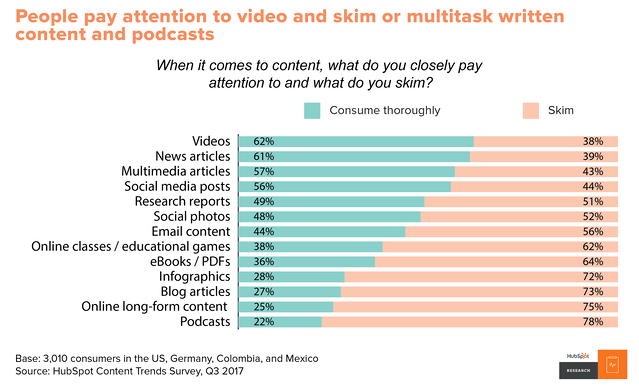How To Attract New Audiences With Episodic Content Marketing
Contents
The internet is currently oversaturated with content and getting your articles or videos noticed by your target audience is often a very complicated task, especially if you’re not publishing regularly.
Many businesses have now adopted the episodic content approach in order to keep their readers engaged and wanting more.
“So what is episodic content?” you may ask. Imagine you wrote an extensive and well-researched long-read and you’re confident that it may as well be one of the most informative articles on the topic at hand.
Why would you give it away all at once, when you could turn it into a series?
We’re certain that most businesses will benefit from this approach. It’s safe to say that episodic content will compel content creators to write better articles or produce greater videos, but they will also be able to attract a broader audience.
Let’s dive right in, shall we?
What Kind Of Content Do I Create?
First off, you need to establish what kind of content you’re going to produce. As we’ve mentioned previously, you can create articles and videos, but besides that, you can also tap into podcasts and even infographics.
It’s best to decide what content you’re going to start producing based on your audience and their preferences. Because when it comes to content marketing, you really need to understand the generation you’re catering to.
So, let’s look into the four primary age groups:
- Baby Boomers (range from 50-70 years)
- Generation X (range from 35 – 50 years)
- Millennials, or Generation Y (18 – 34)
- Generation Z, or iGeneration (Teens)
The so-called boomers are more passionate about books and longer videos. Representatives of Generation X prefer shorter videos and blogs. Millennials are all about short videos, short blogs, and listicles, and the iGeneration are into very short videos and images.

There are also differences in how thoroughly various types of media are consumed. Unfortunately, long-form articles and podcasts are often skimmed. You should take this into account when deciding what type of content to provide to your audience.
How Do I Make My Content Episodic?
The essential aspect of a successful episodic approach to create episodic content is an intriguing “plot,” whatever content type you choose to go with. Think of it as a scenario to an informative and niche TV series on a narrow topic.
You could even go as far as having a protagonist in your video series, articles, or what-have-you. This is a great idea because if you carefully craft their personality, your customers will be able to relate to them and even identify with the main character.
It’s essential to have a well-defined buyer persona, especially before trying to create an engaging protagonist (not that you don’t need a buyer persona otherwise).
Why Use Storytelling In Episodic Content?
People are passionate about stories and personal accounts because we need to know that we’re not alone when it comes to facing issues. We need to know that struggling with something is A-OK, and even people that are important figures in a particular niche have struggled with moments of weakness. Use your protagonist to underline that.
Tapping into another individual’s struggles is proven to have a powerful effect on our brains. An exciting and relatable plot will skyrocket our oxytocin levels, one of the “feel-good” hormones in our bodies, according to the study published by Paul J. Zak back in 2013.
Storytelling is one of the factors that define high engagement and “shareability” of your content. In effect, if you’re producing episodic content, this will create a funnel, where a person that is new to your brand and the material you put out will be compelled to watch or read all of it.
Many leading writing services like WoWGrade.net have incorporated storytelling into the texts they produce and recommend it to their customers across the board. Just because it works.
Here’s a great example of how Coffee with a CMO uses storytelling to create an engaging narrative. They often discuss the trials and tribulations of business owners, which is a valuable insight into the life of high-class professionals. This is both captivating and informative.
Another notable example of episodic content is the Facebook Watch videos published by Humans of New York. They’ve expanded their content from just photos and text by adding videos to their arsenal. The series is extremely successful and has amassed millions of views on Facebook.
How Do I Create Anticipation?
We all know that feeling.
You know?
When you’re at the very end of an episode, and there’s an unresolved conflict, and the curtains close at its very apogee?
Isn’t this why people binge on shows on Netflix?
This is how you stimulate curiosity. To find out how the conflict resolved, you need to watch the next episode. And when you’re done with that — bummer, there goes another cliffhanger. You want this in your content as well.
So, how do you create anticipation in your episodic content?
- Boil down each episode into its central ideas. Let’s say every 1000-word article you’ve planned has about 4-5 significant points or takeaways.
- Analyze the interdependencies between these points. Are there any complex ideas in your articles, which can’t be adequately explained without covering a more basic topic?
- If so, partly cover the more complex topic “X” at the end of an episode and then interrupt by telling the reader that in order to properly understand this idea, they need to first take a look at topic “Y”, which incidentally will be discussed in the next, chapter, episode, article, and so forth.
- Commence the next episode by explaining the basic “Y” concept and resume covering topic “X,” once you’re done with that.
This model pretty much explains why episodic content is so good at amassing more consumers and subscribers.
What About Mediums And Formats?
There are people who love watching videos, and there are also people who appreciate good writing. If you’re looking to create a series that will extensively cover a broad topic, try switching up your formats once in a while.

If, say, you started your series with a few video episodes, why not drop an occasional infographic or article as one of the episodes?
This will allow you to diversify the audience that will be interacting with your content and the platforms when it will be shared too. You can also experiment with adapting certain episodic video content to various social media.
Conclusion
When approached correctly, episodic content can help you put your brand on the map and shine through the flood of daily published content on social media and other niche websites.
This allows your business to create a meaningful presence online, along with establishing an authoritative voice in the industry. Good luck!
-2.png)




